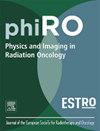A method for sensitivity analysis of automatic contouring algorithms across different contrast weightings using synthetic magnetic resonance imaging
IF 3.4
Q2 ONCOLOGY
引用次数: 0
Abstract
Background and purpose
A majority of institution-specific automatic magnetic resonance imaging (MRI)-based contouring algorithms utilize one contrast-weighting (i.e., T2-weighted), however their performance within this contrast-weighting (i.e., across different repetition time, TR, and echo time, TE) is under-investigated and poorly understood. The purpose of this study was to develop a method to evaluate the robustness of automatic contouring algorithms to varying MRI contrast-weightings.
Materials and methods
One healthy volunteer and one patient were scanned using the multi-delay multi-echo (MDME) scan on a 3T MRI. The parotid and submandibular glands in these subjects were contoured using an automatic contouring algorithm trained on T2-weighted MRIs. Ground truth consensus contours were created by two radiation oncology residents and one pre-resident physician. A total of 216 different TR and TE combinations were simulated across T1-, T2-, and PD-weighted contrast ranges using SyMRI. Comparisons between automatic contouring algorithm contours and the ground truth were determined using the Dice similarity coefficient (DSC) and 95th percentile Hausdorff distance (HD95) with interobserver variability used as a threshold for clinical acceptance.
Results
Differences in the automatic contouring model’s performance were seen across the contrast-weighted regions. The range of discrepancy in DSC and HD95 exceeded 0.2 and 3.66 mm, respectively. In the T2-weighted contrast region, 100 %, 40 %, 24 %, and 57 % for the DSC in the left parotid, right parotid, left submandibular, and right submandibular gland, respectively, exceeded interobserver variability.
Conclusions
This study demonstrates the variable performance of MRI-based automatic contouring algorithms across varying TR and TE combinations even within the same contrast-weighting region (i.e., T2-weighted).

利用合成磁共振成像技术对不同对比度权重的自动轮廓算法进行灵敏度分析
背景和目的大多数机构特定的基于自动磁共振成像(MRI)的轮廓算法使用一种对比度加权(即t2加权),然而,它们在这种对比度加权(即不同重复时间,TR和回波时间,TE)中的表现尚未得到充分研究和了解。本研究的目的是开发一种方法来评估自动轮廓算法对不同MRI对比权重的鲁棒性。材料与方法对1例健康志愿者和1例患者进行3T MRI多延迟多回波扫描。这些受试者的腮腺和下颌下腺使用t2加权核磁共振成像训练的自动轮廓算法进行轮廓。基础真相共识轮廓是由两名放射肿瘤学住院医师和一名住院医师创建的。使用SyMRI在T1、T2和pd加权对比范围内模拟了216种不同的TR和TE组合。使用Dice相似系数(DSC)和第95百分位Hausdorff距离(HD95)来确定自动轮廓算法轮廓与地面真实度之间的比较,观察者之间的可变性被用作临床接受的阈值。结果在对比加权区域,自动轮廓模型的性能存在差异。DSC和HD95的差异范围分别超过0.2和3.66 mm。在t2加权对比区,左侧腮腺、右侧腮腺、左侧下颌骨和右侧下颌骨的DSC分别为100%、40%、24%和57%,超过了观察者间的可变性。本研究表明,即使在相同的对比加权区域(即t2加权)内,基于mri的自动轮廓算法在不同的TR和TE组合中也具有不同的性能。
本文章由计算机程序翻译,如有差异,请以英文原文为准。
求助全文
约1分钟内获得全文
求助全文
来源期刊

Physics and Imaging in Radiation Oncology
Physics and Astronomy-Radiation
CiteScore
5.30
自引率
18.90%
发文量
93
审稿时长
6 weeks
 求助内容:
求助内容: 应助结果提醒方式:
应助结果提醒方式:


